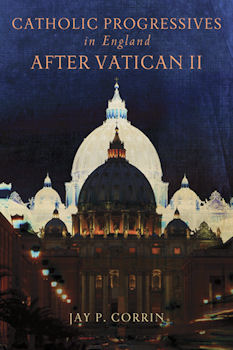
|
Posted February 19, 2014
Book: Catholic Progressive in England after Vatican II Author: Jay P. Corrin Notre Dame Press. Notre Dame, IN. 2013. Pp. 523 An Excerpt from the Introduction:
The purpose of this study is to examine the evolution of Catholic social thinking from the end of World War II up through the 1960s. Vatican Council II signaled the victory of what can be identified as the Catholic liberal or progressive tradition, the earlier history of which was the subject of my book Catholic Intellectual and the Challenge of Democracy (2002). Thanks to the ground-breaking work of such Catholics as Jacques Maritain, Virgil Michel, Don Luigi Sturzo, George Shuster, Godfrey Diekmann, John Courtney Murray, Hans Kung, and H.A. Reinhold, among others, there was firmly in place by the time of the calling of the Council a platform from which the Church might launch a progressive, reformist approach to the secular challenges of the modern age. These Catholics were champions of liturgical reform, which aimed to reintegrate Christians with the Mystical Body of Christ as a means of extending Christianity into the broader realms of the community. They believed that the ills of excessive capitalism and its opposite, collectivism, could be attenuated by reforming the thought processes and values of modern society. But this was to be a social reconstruction that had to be preceded by renewal of the Christian spirit, where the doctrine of the Mystical Body of Christ uniting Christians with Christ could serve as the link between liturgy and sociology. As noted by Virgil Michel, this would "revive and foster determination to carry Christ-life into the social and economic sphere." An Excerpt from the Book: A group of Catholic theologians over a number of years had been searching for ways to elicit new meanings from scripture and to open up Church structures for greater lay participation through liturgical renewal. One of the seedbeds for what came to be called the "New Theology: was the University of Tubingen, where Protestant and Catholic scholars had joined together as teaching faculty. In such close working quarters there occurred a cross-fertilization of religious ideas. Collegial interaction with Protestants also obliged Catholic academics to reexamine the more static neo-Thomistic theological structures in an attempt to increase their humanistic appeal. As early as the 1920s and 1930s two German scholars, Romano Guardini and Karl Adams in their search for fresh ways of approaching theology began to assert that the heart or "essence" of the Church lay not in its dogma and rules but in the human existence of Jesus Christ. Above all, the claimed that the Church had to be understood not as a hierarchical institution privileging bishops and priests but as a community of believers united by the Holy Spirit. Table of Contents: Part one The English Cultural Setting One: The Church of England Two: The sources of English Catholic radicalism Three: English Catholics and the establishment Part two Four: Reinforcing the citadel Five: The role of John XXIII Six: The Council Seven: Vatican II come to Britain Part Three The Revolutionaries Eight: The Catholic new left Nine: The Slant movement Ten: The quest for new community and culture Eleven: Jesus and Marx: a Christian Marxist convergence? Twelve: Charles Davis and the McCabe affair Thirteen: What must be done? The Catholic left and British politics Fourteen: Legacy and impact |
|
